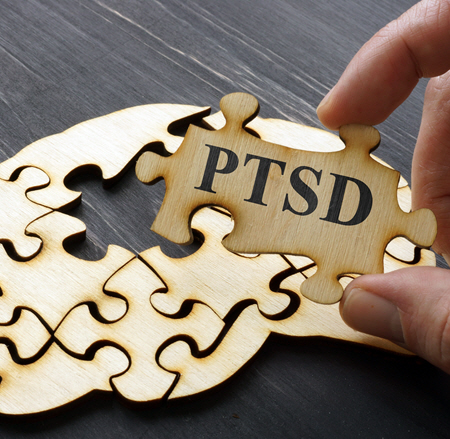Healing doesn’t mean the pain never existed. It means the damage no longer controls our lives.
– B. K. Shivani
 What is PTSD?
What is PTSD?
Post-Traumatic Stress Disorder (PTSD) can develop after witnessing or experiencing one or multiple life-threatening events (traumas) that overwhelm a person’s ability to cope with everyday life. Examples of single events are a car accident, a medical procedure, or a fire. Multiple or complex events may include chronic illness, family violence, ongoing illness, or living or working in a toxic, stressful environment.
Most people have experienced negative or challenging stressors in their lives. However, not everyone develops PTSD and can adjust to these stressors. More positive life experiences and adequate support allow people to adapt to what happened, with the person’s relative sense of safety remaining intact.
However, under certain conditions, the nervous system gets stuck and can’t assimilate and let go of what happened. Certain risk factors, such as experiencing childhood trauma or neglect, working in a high-risk job, having a foster care history, having a family history of mental health or substance use, and having very little or no social support following the trauma, increase the risk of developing PTSD.
When the alarm bell of the emotional brain keeps signaling that you are in danger, no amount of insight will silence it.
– Bessel van der Kolk, M.D.
 Stuck in States
Stuck in States
People with PTSD often become caught up in the state at the time of the trauma(s) in their everyday lives, even though the threat has passed. These responses can occur so fast that the brain doesn’t have time to reason and talk oneself down with a present-time perspective. Those experiencing PTSD respond in the following ways:
Fight: an impulse to aggress (urges to punch or kick, yell, or express intense anger)
Flight: the impulse to get away fast (fidgety, restless, trapped, avoidance)
Freeze: the impulse to freeze up (rigid, frozen, panicked, dread, shallow/held breath)
Fall: the impulse to numb out (slowed energy/movement, shut down, disconnected, fixed gaze)
Fawn: an impulse to please others (troubles saying no or not voicing own needs or wants)
 Here are some Signs and Symptoms:
Here are some Signs and Symptoms:
People with PTSD endure severe anxiety. Bursts of uninvited old memories surface in reaction to obvious or subtle trauma reminders. These flashes can be visual, body, or emotional memories.
Nightmares are also common. Falling asleep is challenging because the body can’t relax, and sleep is broken and restless.
Avoiding inside and outside reminders keeps the accompanying intense body sensations, images, and emotions at bay. Suddenly thinking, feeling, and acting younger (the age at the time of the trauma) or feeling floaty or disconnected can occur in those with severe or complex trauma histories.
Being “on guard” or watchful is frequent. Loud noises or people entering the room might cause one to jump out of their skin, even if the person who approached or the noise itself was harmless. Risk-taking or adrenaline-pumping activities are relied on to feel “alive” and reduce numbing. Shutting down and feeling depressed is prompted by high-anxiety exhaustion and self-blame.
Because the brain can’t function, PTSD compromises performance at work or school. Close relationships become the hardest hit, and friendships are difficult to establish and maintain.
 Therapy Methods for PTSD are available.
Therapy Methods for PTSD are available.
There are many treatment options to recover from PTSD.
Those treatments include Adaptive Internal Relational (AIR) Network Model, Brainspotting, Exposure Therapy, Eye Movement Desensitization and Reprocessing (EMDR), Internal Family Systems (IFS), Neurofeedback, Sensorimotor Psychotherapy or Somatic Experiencing (body-oriented methods), Trauma-Focused Cognitive-Behavioral Therapy (TF-CBT), and Trauma-Informed Yoga.
How do you choose?
What’s most important is to select a provider who states a specialty and experience in treating trauma-related symptoms and PTSD. Therapists trained in multiple approaches can better individualize treatment.
Having a positive working relationship with the therapist is vital. Trusting your gut when selecting and meeting with a new therapist is essential, and it’s OK to change your mind and shift to someone new or request a different method.
There’s Hope for Healing.
Relief from PTSD and trauma is possible with personalized support and treatment.
Start living again!
Reach out today for your free 15-minute consultation, and we can see if what I offer is a good fit for you.
Once you choose hope, anything is possible.
– Christopher Reeve

